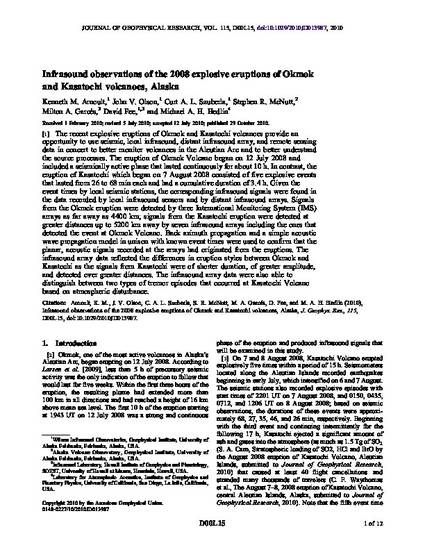
- volcano,
- infrasound
The recent explosive eruptions of Okmok and Kasatochi volcanoes provide an opportunity to use seismic, local infrasound, distant infrasound array, and remote sensing data in concert to better monitor volcanoes in the Aleutian Arc and to better understand the source processes. The eruption of Okmok Volcano began on 12 July 2008 and included a seismically active phase that lasted continuously for about 10 h. In contrast, the eruption of Kasatochi which began on 7 August 2008 consisted of five explosive events that lasted from 26 to 68 min each and had a cumulative duration of 3.4 h. Given the event times by local seismic stations, the corresponding infrasound signals were found in the data recorded by local infrasound sensors and by distant infrasound arrays. Signals from the Okmok eruption were detected by three International Monitoring System (IMS) arrays as far away as 4400 km; signals from the Kasatochi eruption were detected at greater distances up to 5200 km away by seven infrasound arrays including the ones that detected the event at Okmok Volcano. Back azimuth propagation and a simple acoustic wave propagation model in unison with known event times were used to confirm that the planar, acoustic signals recorded at the arrays had originated from the eruptions. The infrasound array data reflected the differences in eruption styles between Okmok and Kasatochi as the signals from Kasatochi were of shorter duration, of greater amplitude, and detected over greater distances. The infrasound array data were also able to distinguish between two types of tremor episodes that occurred at Kasatochi Volcano based on atmospheric disturbance.
Journal of Geophysical Research, v. 115, issue D2, art. D00L15
Copyright 2010 by the American Geophysical Union.
Available at: http://works.bepress.com/stephen-mcnutt/37/
